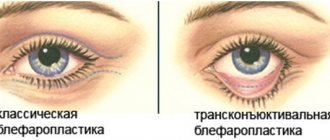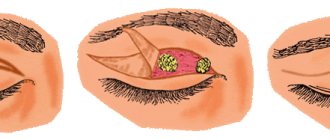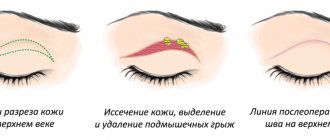The skin of the eyelids is the thinnest on our face. Naturally, with age, it gradually becomes flabby, folds and bags appear under the eyes. Plastic surgery offers a radical and effective solution to this problem - the operation is called blepharoplasty. Her technique has long been developed and is used all over the world. However, as with all plastic surgery, there are many nuances. We met with aesthetic surgeon Gvaramia Alexey Alekovich, who has been performing blepharoplasty and other plastic rejuvenating operations on the face for more than 20 years, and decided to talk about the main points of eyelid surgery.
— Alexey Alekovich, first of all, thank you for your time, tell us what are the indications for eyelid surgery?
Blepharoplasty is performed for congenital or age-related indications. Age-related indications are the so-called fatty hernias in the lower eyelid area: the fat mass bulges in the lower eyelid. There are two mechanisms: first, the orbital muscle weakens, and the fatty mass that surrounds the eyeball begins to bulge. And the second mechanism: age-related formation of excess skin.
Fatty hernias on the eyelid are congenital. At a young age it looks cute: small swellings add charm to a child’s face, but over the years it begins to make a person look very old.
— There is an opinion that blepharoplasty is done only in adulthood. Can this operation be performed on young people?
Yes, blepharoplasty can be done on young people. In my practice, there were very young model patients who came to the clinic with their parents. The parents signed the contract because Contracts can only be concluded with adults.
— Tell me, how many times in your life can you have blepharoplasty? Some experts argue that no more than three and therefore you need to choose a good specialist in order to protect yourself from alterations...
As a rule, more than three are not required. Repeated blepharoplasties of the lower eyelids must be done very carefully, since with each subsequent operation the scarring process becomes more severe. Although during repeated operations the primary scars are excised, the tissues still become less elastic and more difficult to work with. For example, if, several years after the initial operation, eyelid hernias suddenly appear in the absence of excess skin (poor surgery) and the surgeon decides to remove them with subciliary blepharoplasty, then even without excision of the skin, inversion of the lower eyelid may occur. Such problems usually do not arise with the upper eyelids, but even here we must remember about possible severe scarring.
Patient #1
The operation was performed at 45 years old due to problems with age-related changes. Treatment with creams and masks did not help, so we decided to have blepharoplasty.
Immediately after the operation it was scary to look in the mirror. The view is not the best. The operation lasted 1.5 hours.
The next day the swelling only got worse. Go outside only with sunglasses.
3 days after the procedure, the swelling began to subside. It became easier to move my eyes, the pain was not as strong as on the first day.
The stitches were removed on the 7th day. Feeling better, stopped taking painkillers, antibacterial treatment continues. The bruises have become yellow, the eyelids are insensitive.
Three weeks later, the swelling was still present, but not particularly noticeable. The seam is slightly reddish. The surrounding area is not sensitive and hard.
Improvement occurred after 1.5 months. In the morning the swelling is slightly noticeable, but the doctor said that it will completely disappear by 3-4 months.
Is it true that blepharoplasty is very painful?
Any operation is an intervention in the body, and of course, one cannot expect pleasant sensations from it. It will be somewhat unpleasant for you during blepharoplasty. But we use exclusively high-quality painkillers that will reduce discomfort to a minimum.
The skin of the eyelids is indeed a very sensitive area. After the operation, there will definitely be pain in the places where the stitches are placed. But this, firstly, indicates that everything went correctly, and secondly, it can be relieved with painkillers. Discuss the choice of drug with our specialist - he will help you choose the most suitable remedy.
Some of our patients note that the healing sutures itch quite a lot. This can also cause some discomfort, but like the previous described effects, it passes relatively quickly.
Patient #2
Women fight for youth and attractiveness all their lives. But after 40 years, beauty is difficult to maintain. Surgery to remove sagging eyelids is the best thing that humanity has come up with.
Immediately after the procedure I looked scary. My biggest fear is how to go out into the street like this. There was no pain, I immediately took painkillers. Eyes are puffy and red.
On the second day I felt better. My eyelids were very swollen, I slept with my head held high. Bags under the eyes.
I must have found a qualified doctor, because on the 3rd day the swelling under the eyes began to subside. Everything around me hurt a little. The doctor recommended a light massage, but not self-massage. Go to him every day.
Fourth day - the stitches were removed. The swelling is less, but everything is itchy and itchy. Continue to drip antibiotics, do not touch them with your hands.
After 2 weeks it’s not scary to look in the mirror. The bags under my eyes are almost gone. There is some swelling left on the upper eyelid.
After another 3 days, the skin became better. You can see how it is restored and becomes elastic.
4 months after circumferential blepharoplasty there is no discomfort. When going outside, only wear glasses, because the scars are not completely gone, if the skin around is tanned, they are white.
The struggle for beauty is worth the pain. Surgery is the only way out. The recovery is long, but after rehabilitation there is no need for makeup. The eyes are open.
Author's rating
Author of the article
Alexandrova O.M.
Articles written
2029
about the author
Was the article helpful?
Rate the material on a five-point scale!
( 3 ratings, average: 3.67 out of 5)
If you have any questions or want to share your opinion or experience, write a comment below.
Complications after blepharoplasty. How to avoid them?
Blepharoplasty or eyelid surgery is an effective plastic surgery on the eyelids to correct signs of age or structural features of the eye. Blepharoplasty of the eyelids is one of the most popular operations in Russia. It helps get rid of fatty hernias, excess skin and dark circles under the eyes. As with any operation, no one is immune from negative consequences. Complications after blepharoplasty occur from time to time, so patients planning this intervention need to know about them in advance and the doctor must be informed about them.
A natural reaction to tissue injury is hematoma and swelling. They are considered side effects and are not considered complications after blepharoplasty. To relieve swelling and speed up healing of hematomas, cold compresses consisting of water and ice are used for three days. They must be applied constantly, except during sleep and meals. Also, correct positioning of the head during sleep or rest helps with swelling - the elevation angle should be about 45-60 degrees. After an eyelid lift, many patients complain of complete closure of the eyes within one to two days after surgery. This is normal if blepharoplasty was performed on all four eyelids. Edema tissues under the lower eyelids form ridges that resolve within one and a half to two months. This is a common side effect after an eyelid lift. Usually, to eliminate swelling, massage is used or special physiotherapeutic procedures are prescribed.
Among the complications after blepharoplasty, suture dehiscence sometimes occurs. It is usually associated with the patient's behavior after surgery, when he blinks intensely, involuntarily rubs his eyes with his hands, or exhibits facial activity. To prevent this complication during upper eyelid surgery, specialists prefer to suture with non-absorbable suture material. The location of the seam also matters. If the edges of the wound diverge, it is washed and the stitches are reapplied.
The unskilled work of the surgeon has resulted in such a complication after blepharoplasty as overcorrection. This occurs due to incorrect calculations and removal of excess skin. As a result, either incomplete closure of the eyelids or inversion of the lower eyelid occurs. But sometimes there are prerequisites for overcorrection, for example, the patient’s history of previous eyelid injuries, Graves’ disease (or Basedow’s disease), skin diseases leading to its coarsening. Patients with previous eyelid surgery are also at risk for overcorrection. If the patient has low-set eyebrows or has excess skin tissue, there is also a possibility of overcorrection during blepharoplasty.
If the preoperative calculation is carried out incorrectly, there is a possibility of encountering eyelid asymmetry. If there is significant asymmetry, repeated surgical intervention is indicated, and minor discrepancies, as a rule, disappear over time on their own.
Another complication after blepharoplasty is drooping of the upper eyelid tissue. This is a normal phenomenon associated with swelling of the upper eyelid and weakening of the muscle that lifts the eyelid. Ptosis of the upper eyelid disappears along with the disappearance of hematomas and edema. In rare cases, ptosis lasts up to six months and can disappear unexpectedly and without a trace.
Swelling of the eyelids is often accompanied by a complication such as inflammation of the conjunctiva of the eye. The conjunctiva is a thin, transparent tissue that covers the outside of the eye. Inflammation of the conjunctiva may be associated with poor hygiene after surgery, inflammation of the incision site, or non-compliance with the postoperative regimen, including the requirement to remain calm, not make sudden movements and not bend over. The consequence of inflammation of the conjunctiva (or chemosis) may be dry eyes, a feeling of irritation of the eyes, and blurred vision. In such cases, eye drops to moisturize the conjunctiva and special ointments help.
Dry eyes can also be caused by such an unpleasant complication as lagophthalmos - incomplete closure of the eyes after upper blepharoplasty. Excessive tissue removal leads to a lack of skin and the inability to completely close the eyelid. This complication is observed less frequently with conventional blepharoplasty. In mild cases, lagophthalmos disappears on its own a few weeks after an eyelid lift. If the operation was performed by an unqualified doctor, the patient faces prolonged lagophthalmos, which contributes to the development of keratoconjunctivitis, simultaneous inflammation of the cornea and conjunctiva of the eye. Conservative methods of treatment may include drops of “artificial tears,” as well as various moisturizers and ointments. In difficult cases, repeated surgery is required.
Double vision (diplopia) is a result of direct injection of anesthetic with concomitant damage to the cranial nerves. The risk group includes patients with repeated eyelid surgery. Sometimes the cause of this complication after blepharoplasty is a disruption of the tear film due to movement of the tear duct. A typical case is also damage to the oblique or rectus muscles during a lower eyelid lift. In mild cases, the complication goes away on its own, but sometimes a doctor’s intervention is required.
The most serious complication after blepharoplasty is temporary or permanent loss of vision due to impaired blood supply to the optic nerve due to orbital hemorrhage. Hemorrhage is accompanied by a sharp increase in intraorbital pressure, threatening the blood supply to the vessels of the optic nerve. This is an extremely rare complication (0.01 to 0.05%), but the patient should be aware of this possibility before surgery. The risk group includes patients with repeated eyelid surgery, hypertensive patients, patients who have undergone complex and lengthy surgery, as well as those taking blood thinning medications. Orbital hemorrhage can occur both within the first 24 hours after an eyelid lift and a week after surgery. It requires immediate medical intervention and rapid reduction of orbital pressure. Patients should remember that any surgical intervention has a factor of unpredictability and randomness. This dangerous complication after blepharoplasty can be prevented by avoiding stress and tension that leads to increased pressure (bending, sneezing, coughing, etc.) and observing the requirements of the recovery period.
After blepharoplasty, the area around the intervention may turn reddish-brown due to the slow elimination of blood cell breakdown products. To avoid hyperpigmentation, careful care of the operated area and compliance with the rules of postoperative hygiene are necessary. Regular doctor's examinations and qualified medical personnel will help avoid darkening of the skin around the eyes. Hyperpigmentation can also occur due to increased production of melatonin (tanning pigment), as a post-traumatic skin reaction.
Before deciding to undergo blepharoplasty, you should carefully review the contraindications, risks and possible complications. A careful choice of doctor and clinic will minimize the risks of complications associated with the quality of the surgeon’s work. And compliance with all postoperative recommendations will reduce the likelihood of “accidental” complications due to the patient’s fault. In general, complications after blepharoplasty are not very common, however, if there is an opportunity to reduce the risks, it is better to take advantage of it.










